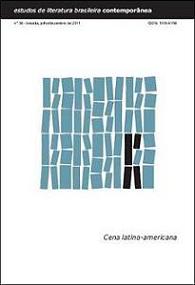Aira como autor de si-próprio?
DOI:
https://doi.org/10.1590/2316-4018388Abstract
O ensaio pretende discutir a relação entre a constituição de uma obra e a elaboração de uma figura autoral, tematizando o processo de construção da fatura literária e o esboço da trajetória de formação de um nome de autor, a fim de relativizar a simplicidade da associação direta entre vida e obra. Por meio do comentário de alguns procedimentos encontrados nas narrativas do argentino César Aira, pretende-se pensar na maneira como um escritor inscreve-se autor no campo literário.
Downloads
References
AIRA, César (2005). Cómo me reí. Rosario: Beatriz Viterbo Editora.
______ (2004) [1998]. Alejandra Pizarnik. Rosario. Beatriz Viterbo Editora
______ (2003) [1991]. Copi. Rosario: Beatriz Viterbo Editora.
______ (2002). La liebre. Barcelona: Emece.
______ (1998). Las curas milagrosas del doctor Aira. Buenos Aires: Ediciones Simurg.
______ (2006) [2001]. Cumpleaños. Barcelona: Del Bolsillo.
______ (1997). La serpiente. Rosario: Beatriz Viterbo Editora.
______ (2003). El tilo. Rosário: Beatriz Viterbo Editora.
BAPTISTA, A. B. (2005). “Excurso - a figuração do autor: os dois primeiros capítulos de S. Bernardo”. In: O livro agreste: ensaio de curso de literatura brasileira. Campinas: Editora da Unicamp.
______ (2003). A formação do nome. Campinas: Editora da Unicamp.
CONTRERAS, Sandra (2002). Las vueltas de César Aira. Rosario: Beatriz Viterbo Editora.
HOPENHAYN, Silvia (1998). “Una novela fuera del canon y sin compromisos con la época: casi todo está permitido.”. La Nación Line. 13 de maio.
KOHAN, Martín (1992). “Repetición y diferencia”. Suplemento el cronista cultural.
LINK, Daniel (2005). Cuadernos hispanoamericanos. Disponível em: <http://www.linkillo.blogspot.com>. Acesso em: 02 de maio de 2010.
PREMAT, Julio (2007). Entre fi cción y refl exión: Saer y Piglia. México: El Colegio de México, Centro de Estudios Lingüísticos y Literarios.
PRIETO, Julio (2007). “Vanguardia y mala literatura: de Macedonio a César Aira”. Disponível em: <http://www.malescribir.de/wp-content/2007/11/malas_escrituras.pdf>. Acesso em: 02 de maio de 2010.
RONAI, Cora (Org.) (2006). Caiu na rede: os textos falsos da internet que se tornaram clássicos. Rio de Janeiro: Agir.
Downloads
Published
How to Cite
Issue
Section
License
Authors who publish in this journal agree to the following terms:
a) The authors maintain the copyright and grant the journal the right of first publication, the work being simultaneously licensed under the Creative Commons Attribution License-Non Commercial 4.0 which allows the sharing of the work with acknowledgment of the authorship of the work and publication this journal.
b) Authors are authorized to enter into additional contracts separately, for non-exclusive distribution of the version of the work published in this journal (eg publish in institutional repository or as a book chapter), with authorship recognition and publication in this journal.
c) Authors are allowed and encouraged to publish and distribute their work online (eg in institutional repositories or on their personal page) after the editorial process, as this can generate productive changes, as well as increase the impact and citation of published work (See The Effect of Free Access).
d) The authors of the approved works authorize the magazine to, after publication, transfer its content for reproduction in content crawlers, virtual libraries and the like.
e) The authors assume that the texts submitted to the publication are of their original creation, being fully responsible for their content in the event of possible opposition by third parties.


